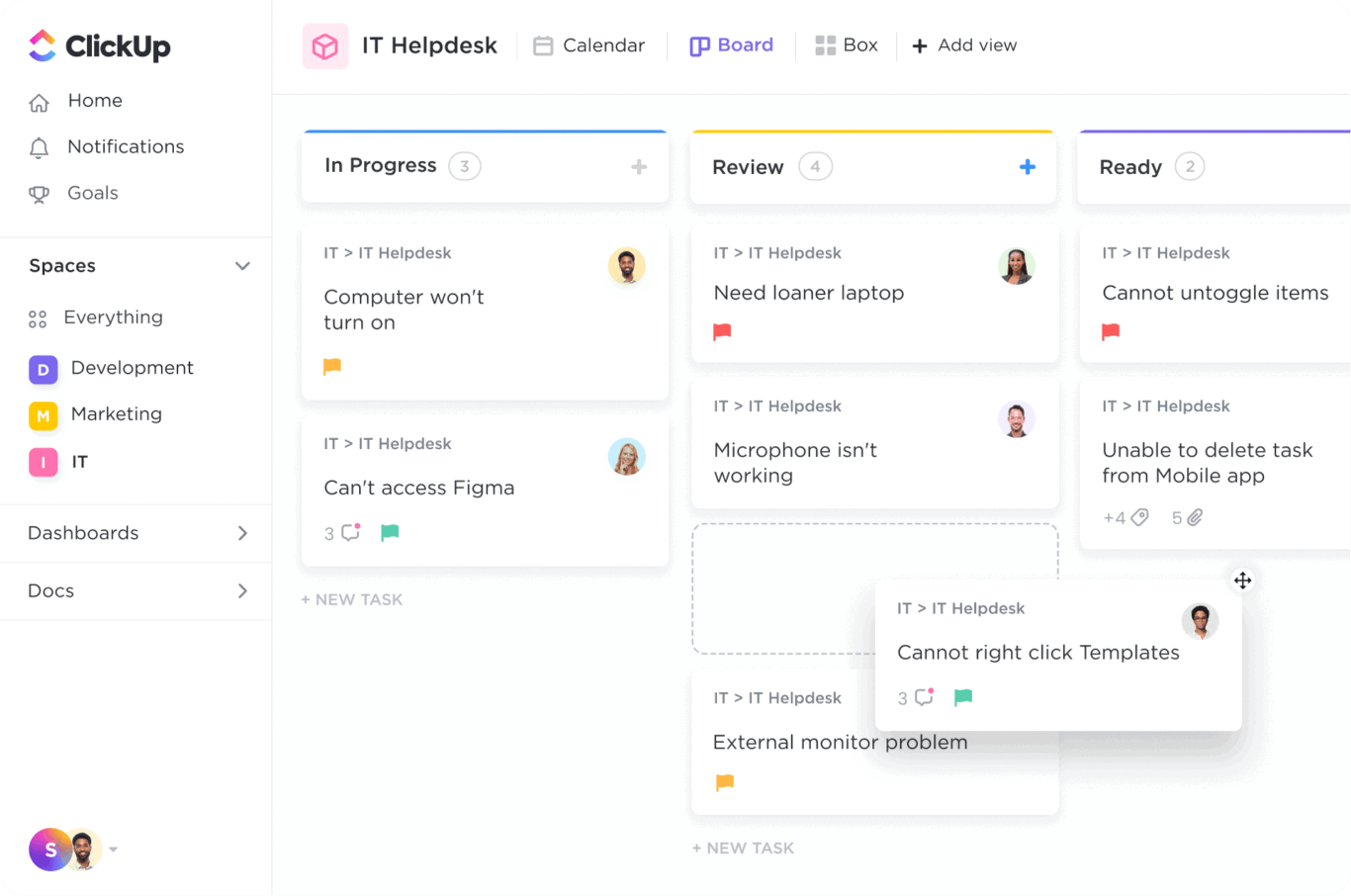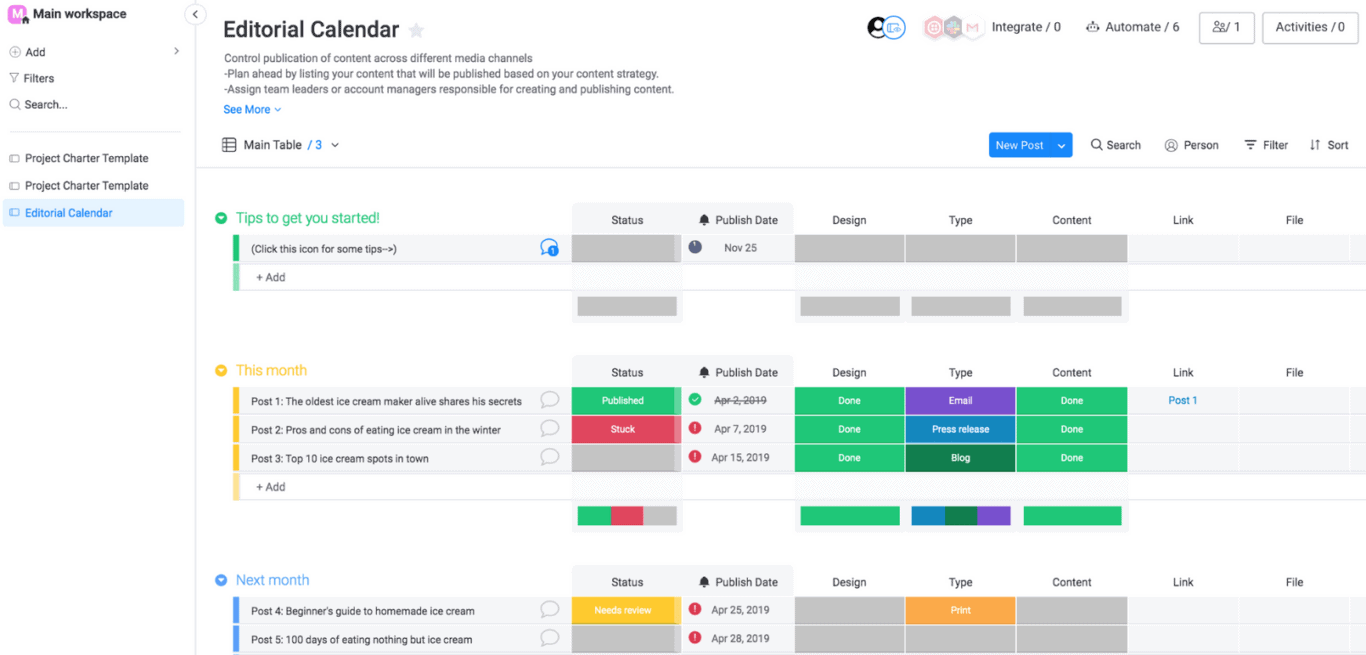ClickUp vs. monday.com: Which Tool Do You Need?
Are you trying to pick out the perfect project management tool for your team? Or maybe you’re working in an organization that’s using two tools and you’re trying to cut spending for SaaS tools? Either way, you need to know who the winner is in the ClickUp vs. monday.com matchup. You’ve come to the right place.
Let’s go over each tool, how much they cost, and why a key difference in how they’re built will likely be the deciding factor for you.
In this article:
What is ClickUp?

ClickUp bills itself as the ultimate productivity hub, and that mentality underscores pretty much every feature. That’s because it’s more than just a project management tool; ClickUp’s task management system is augmented by a whiteboarding tool, built-in messaging, and even a word processor. The team behind ClickUp wants the app to be the single place where all your work happens, and you could potentially replace as many as half a dozen tools with it.
What is monday.com?

The monday.com platform is categorized as a Work OS on its website because it’s designed to help you run any and all projects — much like your computer’s OS allows it to run apps. Where ClickUp goes for an all-in-one approach, monday.com has a more hardcore focus on project and task management. You won’t get a word processor in monday.com — instead you’ll get an integration that embeds Google Docs in your tasks. That difference is one of the biggest gaps between the two tools, and creates hardcore aficionados on either side.
So does monday.com eke it out over ClickUp? Let’s find out.
ClickUp vs. monday.com: Pricing
You need to know what a tool can do before you can make sure you’re picking the right one, but you also need to know how much it’ll cost you. There’s no point in seeking out the tool with the most advanced features if the price tag doesn’t make sense.
ClickUp pricing
Here’s a look at ClickUp’s plans:
- Free: You can get by for quite a while with ClickUp’s free plan, since it supports unlimited members, tasks, and projects. You’ll be limited in storage (100MB) and some of ClickUp’s features, like integrations and different views, are locked behind paid plans. You’ll also have a limited amount of uses for custom fields, which are incredibly useful on this platform.
- Unlimited: For $5 per user, per month, you’ll unlock some of ClickUp’s paid features, like Gantt charts, unlimited custom fields, built-in emails, and reporting.
- Business: At $12 per user, per month, you’ll get custom exporting, advanced time tracking, workload management, and advanced dashboards.
- Business Plus: Bump up your spend to $19 per user, per month, you’ll mostly get custom roles and permissions, but you also get access to more automation, the ClickUp API, and custom workload capacities.
ClickUp also offers custom Enterprise plans with single sign-on, white labeling, and more — you’ll just have to contact their sales team to know how much that’ll cost you.
monday.com pricing
Here’s what monday.com’s pricing plans look like:
- Free: You’ll get a bit less from this free plan than you would with ClickUp. You’re limited to only three boards and two team members, but you’ll still be able to get most of your work done within these boundaries.
- Basic: For $8 per user, per month, you’ll get unlimited boards and free viewers, up to 5GP in file storage, and a dashboard for one board.
- Standard: At $10 per user, per month, this plan gets you timeline and Gantt views, calendar views for your work, automation and integrations (though they’re limited to 250 monthly actions each), as well as dashboards that can combine multiple boards into a single view.
- Pro: For $16 per user, per month, this plan will let you control access to boards and docs, unlock time tracking, give you access to the formula and dependency columns, and help you get a lot more out of both automation and integrations (with 25,000 monthly actions each).
Just like ClickUp, monday.com also offers an Enterprise plan with similar features, like security and governance, for a price you’ll have to negotiate with their sales team.
So who wins the ClickUp vs. monday.com matchup on the pricing side? That depends on what you’re trying to do. You’ll get more out of ClickUp’s Free plan, but monday.com’s Standard plan seems to be a better balance of cost and features than ClickUp’s Business or Business Plus plans.
ClickUp vs. monday.com: What do the users say?
A single article can only give you so much information, which is why websites like Capterra are great for getting a lot of feedback on a specific tool quickly. But if you don’t want to prowl through the thousands of reviews on the site to compare ClickUp vs. monday.com, here are some clear takeaways for each tool.
ClickUp
Most users agree that ClickUp is a solid option for project management and collaboration. Despite being an all-in-one solution and lacking the focus of other tools, it’s still a great way to work with your team, especially if you’re collaborating with remote workers.
One of the big complaints from ClickUp users comes from that all-in-one approach: the learning curve. Because there are so many things you can do with ClickUp, it seems like there’s always something new to learn, which can make onboarding new teams tough.
monday.com
This platform’s project management capabilities stand out for users, with some saying that the built-in interface is already easy to use, but that the customizability really takes things to the next level. The automations are also greatly appreciated by monday.com users.
But while its performance as a project management tools is top-notch, there are some limitations that stand out to monday.com users. For one, reporting can be a bit tricky on the platform, since metrics that are essential for some users are missing. Additionally some of monday.com’s fields — like text boxes — feel too limited to be of any use.
ClickUp vs. monday.com: Which is best?
The best way to know which tool is right for your needs is to answer a single question. Do you need an all-in-one solution or a dedicated project management platform? If it’s the former, you’ll probably be better served by ClickUp, since you can keep a lot more of your team’s work in a single platform. You can get pretty far with their free plan, too, which means you can get an extensive testing period without being too limited.
But if you want something that has every feature built with project management in mind, monday.com might be a better option. If you can get by with its more limited free plan — or justify the bigger spend for its paid plans — your project managers will get a lot more out of this tool. Pair this hardcore focus with monday.com’s extensive library of automations and integrations, and you’ll be able to close the gaps between it and the other tools in your stack.
Still not convinced? Check out our comparisons of ClickUp and Trello, ClickUp and Jira, or ClickUp and Asana.
Don’t want to choose? Why not sync both!
Try Unito’s integration between ClickUp and monday.com to keep tasks in sync between projects with real-time 2-way updates whenever changes are made.
Or you can try to connect ClickUp to Jira or ClickUp to GitHub for smoother collaboration with software developers.
How does Unito connect monday.com to ClickUp?
If you’re here because you have some teams using ClickUp, some teams using monday.com, and you’re trying to cut spending or reduce the number of overall licenses you need, you should know that there’s a third option. It’s Unito.
Unito is a no-code workflow management solution with the deepest two-way integrations for some of the most popular tools on the market. That includes ClickUp, monday.com, Asana, Trello, Jira, Google Sheets, Microsoft Excel, and more. With Unito’s integration for ClickUp and monday.com, you can sync data back and forth between the two tools and keep everything up to date automatically.
Whether you’re working in one tool and collaborating with a team that prefers the other or you just don’t want to force your team to choose one tool, Unito is the best way to keep everyone on the same page.
Curious to see how it’s done? Here’s one of Unito’s customers, Digistore24, uses Unito to connect ClickUp with the rest of their tool stack. Or you can try this guide to sync ClickUp and Excel.


